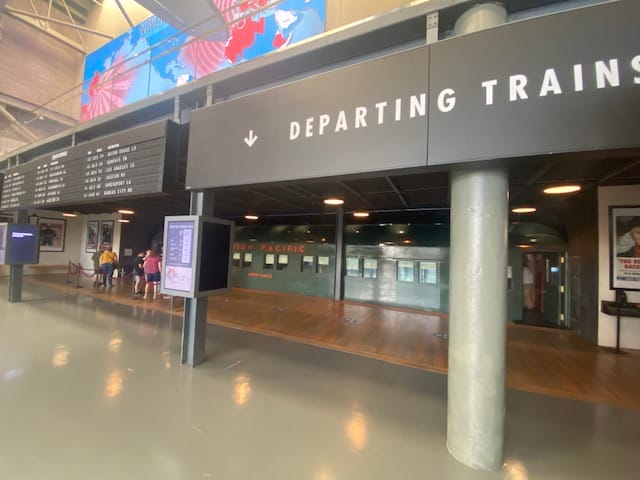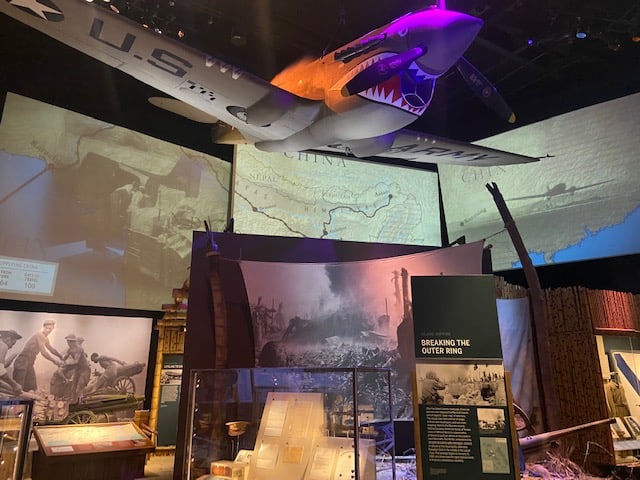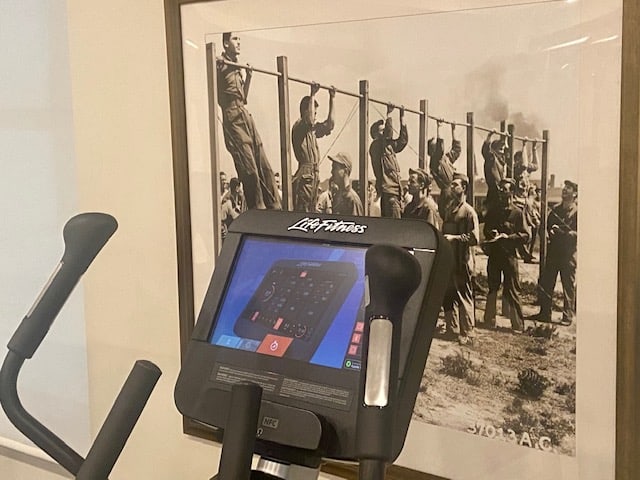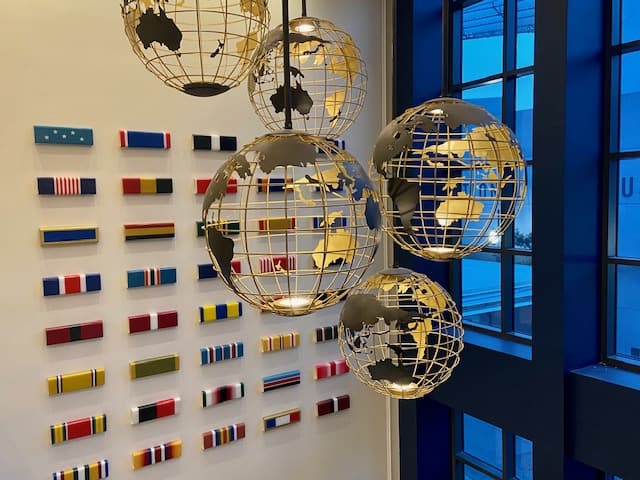
I’d anticipated feeling emotional…but I didn’t expect to be hit so hard, so fast, when touring the National World War II Museum. Afterall, I was born in the late 60’s – more than 20 years after the conclusion of the Second World War – and while I had reverence and appreciation, the era of dancing to Glenn Miller numbers played by an orchestra at the USO was the musty stuff of faded black-and-white photos. But it didn’t take all of the 32,000 square-feet of immersive exhibits ranked the top attraction in New Orleans to grab my heart. It took just one. The very first one.

I Took a Trip on a Train
Upon entering the National World War II Museum’s main entrance – the Louisiana Memorial Pavilion – museum goers encounter what appears to be an American train station platform. Departing Trains the sign reads with an arrow leading to a full-sized, waiting Union Pacific North Platte passenger coach. The train schedule above listed towns such as St. Louis, Montgomery, Houston and Chicago, but for many very young Americans who boarded trains like this beginning in 1940, their final destinations would be places such as Berlin, Midway Island, Omaha Beach, and other battlefronts.
Museum visitors who take a seat in the comfortable train car experience a simulation of the train pulling out of a small town in the USA. The train doesn’t roll anywhere but the seats rumble and the window video images show locals waving goodbye to their sons and daughters as they send them off to war. That’s when the emotions hit me.
“For most Americans who were drafted or enlisted it was their first time going more than 30 miles from their home. A train was the way they left and came home,” said Tom Czekanski, the National World War II Museum’s senior curator and restoration manager. “Many of them took four train trips across the country. There was a sense of trepidation but they also had a great desire to be involved and they knew they had to do their part.”

Taking the Train to Training
Upon stepping off the simulated train ride museum-goers are given an actual dog tag – just as the soon-to-be-soldiers were when they arrived at basic training. That dog tag, electronically, contains the factual information of the real-life soldier so its wearer can check-in at Dog Tag Stations throughout the galleries to follow their story through their war experience and learn how it unfolds…and ends.
“My father and uncle were both in battle,” Czekanski revealed to me. “My father was in the 82nd Airborne and parachuted in on the morning of June 6. My uncle was with the Second Armored Division waiting offshore to get his tank ashore. They actually ran into each other in North Africa.”
Czekanski, who grew up hearing his father and uncle tell war stories, eventually enlisted himself. “My father would tell you they were just doing their job. The real heroes are the ones who didn’t come home. And many of the people who lived through it aren’t with us anymore. The USA used its power and might to preserve democracy. We tell stories of the 16-million Americans who served in the military and people on the home front.”

Veterans Visits from the Greatest Generation
Czekanski’s recognition that, due to aging, America is losing members of the Greatest Generation who fought in WWII, makes their visits to the National World War II Museum very special occurrences.
“We just had a gentleman come from California on his 94th birthday. His daughter arranged a Go Fund Me campaign to cover the cost,” he said. “He was a Navy landing craft driver. He just wanted to see a Higgins Boat again. We actually arranged for him to stand at the helm and it was very satisfying to see how happy he was.”
The Higgins Hotel and Conference Center, virtually brand-new and across the street on the museum campus, is named for the boat Czekanski mentioned. Marc Becker, the 230-room, upscale, themed hotel’s general manager shares the reverence for veterans who visit and stay.
“It’s a good feeling when WWII veterans arrive. We pay special attention to them. The first group we had upon opening in 2019 was a reunion of the Fifth Marine Division Association – the division that stormed Iwo Jima. Eight veterans in their 90’s came with their family members. It was moving because they had lots of stories to share,” said Becker. “Our mission at the Higgins Hotel is to provide accommodation for guests who are visiting the museum and for conferences being held there in addition to operating as a full-service hotel.”
Higgins in Hollywood and the New Hotel
Becker and I spoke in the Higgins Hotel’s Eisenhower Suite. Appropriately it was there, in front of an impressive framed photo of General Dwight Eisenhower, Becker explained the hotel’s name:
“Eisenhower told his biographer Stephen Ambrose ‘Higgins is the man who won the war for us,’ because he was able to produce so many of the landing craft used in the D-Day Invasion and throughout the Pacific: The Higgins Boat.”
A Higgins boat is most commonly recognized as the landing craft used by American troops to storm the beaches of Normandy in the D-Day invasion. Many people now caught their first sight of one during the opening scenes of Steven Spielberg’s 1998 film Saving Private Ryan. (Hanks narrates Beyond all Boundaries, a 4-D special effects-filled film experience in the museum’s Solomon Victory Theater.) Museum-goers can see an actual LCVP Higgins Boat, like the one they saw Hank captain in Ryan, just inside the main entrance.
“It looks more like a shoebox than a boat. The front of the boat makes turbulent water which allows it to get onto the shore and the hull transitions to make still water so the propeller can drive it onto the beach,” Czekanski explained.
It’s meaningful, locally, too.
“Andrew Higgins was an entrepreneur who converted a small company of 40 employees just before the war into a manufacturing powerhouse that produced over 22,000 boats, including the Higgins Boat, liberty ships and aircraft parts. At one point his company had 25,000 employees here in New Orleans working three shifts a day, seven days a week between 1942 and D Day,” said Becker.

Rosie The Riveter was also Instrumental
Becker and I toasted Higgins at Rosie’s on the Roof, The Higgins’ open-air bar overlooking all of New Orleans, while drinking rocks glasses of The Riveter, a cocktail made of light and dark rum, fresh fruit juice, and bitters served in an actual Stanley Thermos. (Pistol Packin’ Mama and 80’s Women Power Ballad IPA were among the other choices nine stories up.) “‘Rosie the Riveter,’ is the iconic caricature personality that represents every woman who served during the war either in uniform or in manufacturing plants. ‘Rosie’ worked in the Douglas Manufacturing plant in California so there is an aircraft wing, perhaps one she riveted, over the bar as an element of surprise for people.”
It is through touches like that The Higgins Hotel turns heads and touches hearts in the midst of the military might with respect, pride, and smiles. For instance, business travelers can hold strategy meetings in the hotel’s Overload Boardroom in front of the floor-to-ceiling map General Eisenhower used at his headquarters on D-Day to track allied ships. General Patton’s piano is in the Patriot’s Circle Lounge; and near Kilroy’s Café, the “provisions” convenience shop sells “rations” of gourmet coffee and treats.

I could go on, but it’ll be more fun for you to discover these treasure hunt-type touches for yourself, including the vintage photos of boot camp soldiers training posted for inspiration on the walls of the hotel’s fitness center. Arriving in the hotel’s bold, soaring, deco-design lobby is like stepping back in time to sense, through sights, sounds, and even tastes, the American experience at home and abroad during the war.

The Longest Day
Becker said the National World War II Museum and its experiential history is worth a two-day visit. You will want to linger as you stand beside authentic aircraft on sky-high catwalks or stroll the snowy “Road to Berlin” gallery. While I found it easy to get lost amidst astonishing items, pictures, videos and the engaging manner in which they are presented, I recommend wandering the halls of the various buildings in bites. A stay at The Higgins will allow you to duck back to the hotel for a break. The Higgins’ bright, celebratory design provides a purposeful lift from the emotional fog of war the museum’s immersive, 4-D exhibits may provoke.
For instance, by visceral contrast, at the hotel, the elevator doors open to reveal a vintage photograph of relief and jubilation: a smiling group of people holding up fresh copies of the Knoxville Journal emblazoned with the banner headline: WAR ENDS!
You needn’t tour the National World War II Museum in order to stay at The Higgins Hotel or enjoy it. It is The Big Easy, after all, and the Higgins Hotel New Orleans – Curio Collection by Hilton, is centrally located in the Arts District between the French Quarter and the Garden District.

Read more of Michael Patrick’s work at The Travel Tattler, or contact him at [email protected]
